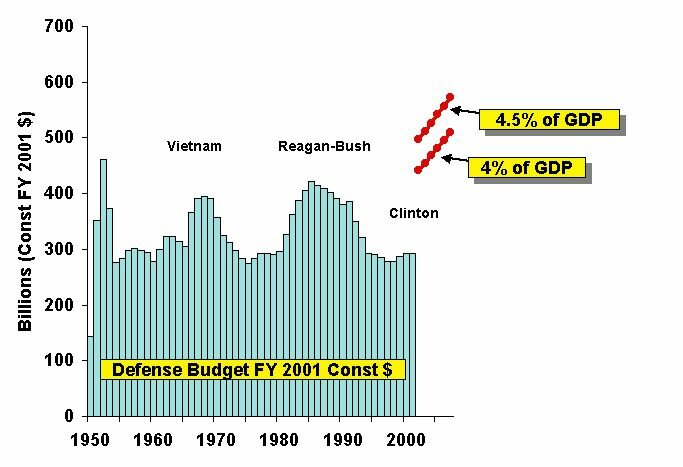|
The Real Cost Of Spending 1% More Of GDP On Defense September 20, 2000 Comment: #386 Discussion Thread: #s 169, 364, 381, 383; New readers might also want to consult #s 61, 72, 102, 114, 117, 130, 131, 146, 154, 159, 166, 184, 193, 328 As reported in Comments #381 and 383, there are growing calls for increasing the defense budget from 2.9% to 4% of GDP. There are two common denominators in these calls: None that I have seen (1) tells the reader how much that seemingly small 1% increase would be, and (2) how that 4% Solution would compare with the levels of spending by our potential adversaries. Attached herewith for your information is another perspective on the omitted information. It is a commentary on the 4% Solution I wrote that appeared in Defense Week on September 5, 2000. The important thing to note that it does not matter whether one uses constant dollars or current dollars. Both calculations lead to EXACTLY THE SAME CONCLUSION. This can be seen directly by comparing the concluding paragraphs (below the figure) in the Defense Week article to the Conclusion section in Comment #381. For your convenience and future reference, the constant and current dollar charts placing the 4% Solution in the context of past budgets as well as a comparison with threat spending are available at the following three Defense and National Interest Website URLs: Begin Defense Week Commentary The Real Cost Of Spending 1 Percent More Of GDP On Defense COMMENTARY As the 2000 election nears, a rising chorus demands an increase in U.S. military spending from the current 2.9 percent of Gross Domestic Product to at least 4 percent. However, these observers don't mention a critical piece of the picture: how much that increase would cost in dollars, not percentage points. According to the latest figures from the Office of Management and Budget, spending at least 4 percent of GDP on defense in the next six years would result in nearly doubling the Pentagon's current budget by 2007. That level of spending would dwarf the buildup overseen by President Ronald Reagan. Among those calling in recent weeks for a defense budget that increases to at least 4 percent of GDP, and in some cases to 4.5 percent, are Frank Gaffney, president of the Center for Security Policy, a national-security think tank; Gen. James Jones, commandant of the Marine Corps; and Adm. Jay Johnson, recently retired Chief of Naval Operations. In 1998, Gen. Gordon Sullivan, retired Army Chief of Staff, also made the proposal. But the Office of Management and Budget's most recent prediction of GDP levels, released in June, makes clear the implications of such a policy. The table below shows the GDP projections for 2002 through 2007, the years covered by the next Future Years Defense Plan, and how much is implied by 4 percent and 4.5 percent of that pie. The dollars are in billions with the effects of inflation removed.
The chart below places the 4 percent of GDP calls in historical context. It depicts in constant fiscal 2001 dollars how a seemingly modest increase of 1 percent of GDP would create a Pentagon bigger than the Cold War version more than a decade after the Cold War ended. [For those readers with email browsers that do not show imbedded graphics, click here.]
The 4 percent solution, if implemented in this decade, would be tantamount to a declaration of total war on Social Security and Medicare in the following decade. Such a war could be justified only if our nation's survival was at stake, which brings us to the second omission in the Gaffney-Jones-Johnson-Sullivan proposal: how much the putative bad guys are spending. In 1999, the most recent year for which data is available, the United States spent almost three times as much as the combined expenditures of Russia, China, Iran, Syria, Iraq, Libya, North Korea, Serbia, Cuba, and the Sudan - the states most often considered as potential adversaries. Add in the spending by our allies, and the current spending advantage rises to five and a half to one. Under Secretary of Defense Jacques Gansler was correct in Sept 1998 when he said the Pentagon is in a Death Spiral, but it is caused by interaction of three problems: (1) a high-cost modernization program that makes it too expensive to modernize the force on a timely basis, even if current production plans are perfectly executed; (2) a rapidly deteriorating readiness posture brought on by the rising cost of low readiness, which is in part a consequence of the flawed modernization program; (3) a corrupt accounting system that renders it impossible to assemble the detailed information needed to fix the modernization and readiness problems and makes a mockery of the accountability principle that underpins the checks and balances of the Constitution. To these problems, the military-industrial-congressional complex's only answer is a question: Can we please have a bailout? If they get one, it will not only continue the Cold War ways. It will spark a new war between America's senior citizens and its military that didn't have to happen. End Defense Week Commentary Chuck Spinney [Disclaimer: In accordance with 17 U.S.C. 107, this material is distributed without profit or payment to those who have expressed a prior interest in receiving this information for non-profit research and educational purposes only.] |
||||||||||||||||||||||||||||||||
